Do you know what marketing campaigns and channels are generating the majority of your customers & revenue? What about how certain channels compare in terms of ARPU, customer retention & LTV?
If you don’t have the tools to answer these questions, then you could be wasting your marketing budget on campaigns that might drive visits and signups, but don’t convert into customers (or the customers it does generate pay you lower amounts and churn quickly).
Fortunately, there is a solution.
By capturing marketing channel data and sending it into ChartMogul, you can run reports that show you exactly what channels and campaigns are generating customers & revenue.
Why you need to capture marketing channel data
Let’s imagine you run a B2B SaaS business and run both Facebook Ads and Google Ads to acquire new customers.
If you were just using tools like Google Analytics (which only track visitors to your website), you’d probably get something like this:
| Facebook Ads | Google Ads | |
| Spend | $10,000 | $10,0000 |
| Visitors | 2,000 | 1,000 |
| Goals (Signups) | 200 | 100 |
If this was all the information you had access to, then it would look like Facebook Ads are outperforming Google Ads as you got 2x more signups for the same budget.
However, imagine if you were tracking these campaigns inside ChartMogul and could see the results of these campaigns in terms of Customers, MRR, ARR, ARPU, etc.
You’d have something like this:
| Facebook Ads | Google Ads | |
| Spend | $10,000 | $10,0000 |
| Visitors | 2,000 | 1,000 |
| Signups | 200 | 100 |
| Customers | 20 | 50 |
| ARR | $8,000 | $25,000 |
| ARPU | $400 | $500 |
When you’re able to analyse campaign effectiveness in terms of number of customers, ARR added & ARPU it’s a different story. In this case, Google Ads is far better because:
- You got 50 customers from Google Ads instead of 20 from Facebook Ads
- Your conversion rate from signup to customer is 50% from Google Ads, but only 10% from Facebook Ads
- You are adding $25,000 in ARR from Google Ads but only $8,000 in ARR from Facebook Ads
- Your average revenue per user from Google Ads is $500 as opposed to $400 per user from Facebook Ads
- Your cost of acquiring a customer through Google Ads is $200 as opposed to $500 through Facebook Ads
As you can see, when you track your marketing campaigns and channels all the way through to Customers, ARR & ARPU you get a much better picture of what’s working and what’s not, and subsequently where you need to invest more to grow.
How to capture marketing channel data in ChartMogul
Step 1: Tag your ad campaigns
In order to know where your customers are coming from, you first need to tag your ads & campaigns.
This includes ads on social networks like Facebook, Twitter & LinkedIn, in search engines like Google & Bing, and in any bespoke campaigns you do in places like trade publications.
The best way to do this is to use UTM parameters. UTM parameters are essentially little extra bits of information that you add on to the links behind your ads that inform analytics tools where the traffic is coming from.
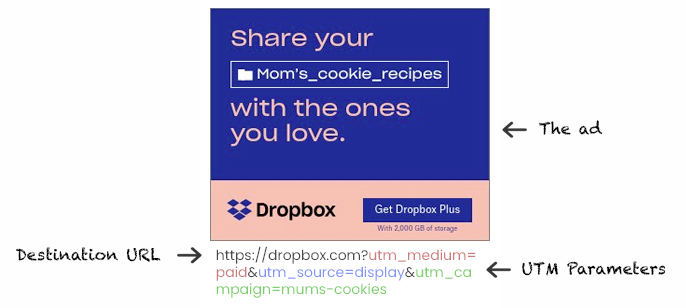
There are a number of tools that you can use to build them, including Google’s Campaign URL Builder and this free one from Attributer.
Step 2: Implement a tracking tool
Now that you have tagged your ad campaigns, you need to implement a tool on your website that can read these tracking links and send the data into ChartMogul.
One such tool is Attributer.io
Attributer is a small piece of code that you place on your website that looks at the UTM parameters (and other information) and determines where the visitor came from (i.e. Paid search, Paid social, Organic search, Email marketing, etc).
Attributer then stores this information in a cookie and when the visitor completes a form (i.e. the signup form for your product) it writes this information to hidden fields you add to your forms.
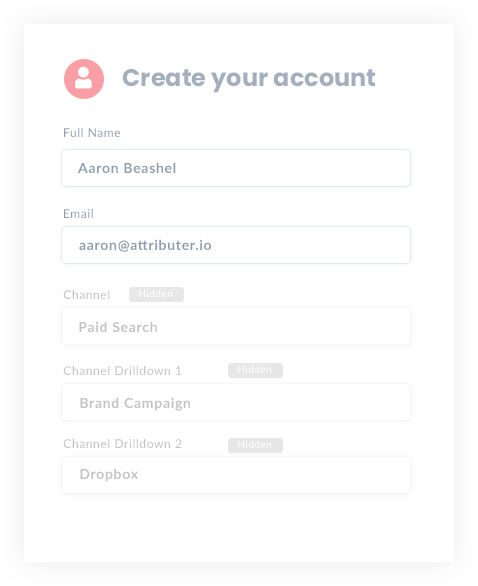
Step 3: Send the data to ChartMogul
Now that all of your signups have marketing channel information being captured alongside their details (i.e. name, email, phone, etc) in the form, it’s time to send that data into ChartMogul.
At Simul Docs we use Stripe as our billing platform, so we send the data to our Stripe account as additional properties against the customer.

From there, ChartMogul automatically pulls this customer metadata into our account as custom attributes.
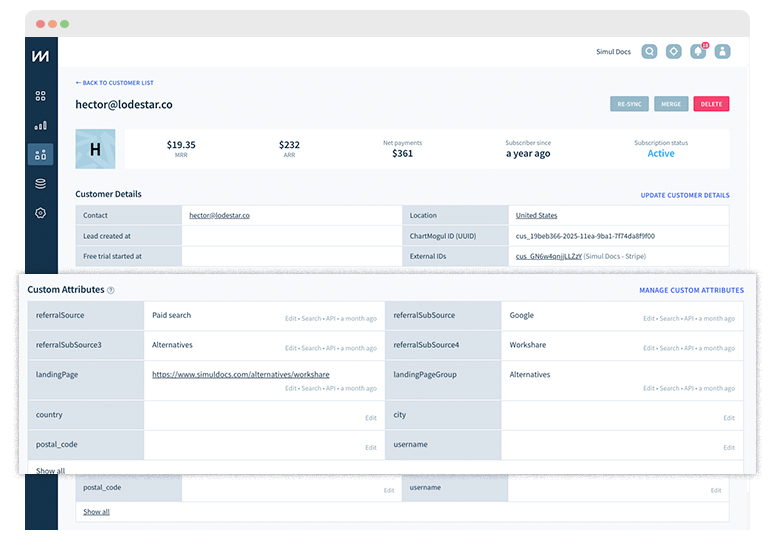
With these customs attributes inside ChartMogul, we can use them to segment different reports and see how metrics like Customers, ARPU, LTV and ARR differ by channel.
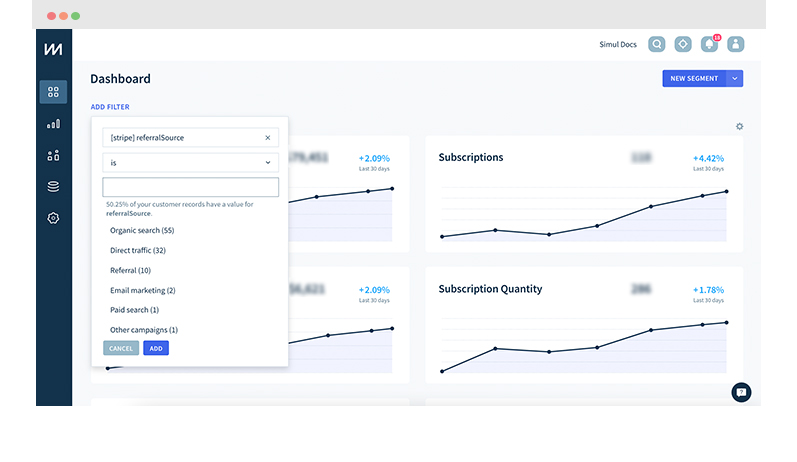
If you don’t use Stripe (or for whatever reason aren’t able to send the data into ChartMogul that way), ChartMogul provides a number of other ways to get marketing channel attribution data into your account, including:
- Sending them in via Zapier
- Adding them via the Enrichment API
- Adding them via Google Sheets
- Manually adding them via the ChartMogul interface
Further information on all of these different methods can be found at ChartMogul’s help center.
What you can do with this data
With marketing channel attribution data flowing into ChartMogul, you can then analyse your different marketing channels by critical revenue metrics rather than by just the number of website visitors.
Further to that though, tools like Attributer will also pass in more granular detail about each channel, such as Campaign Name, Ad Group & Ad Name for paid channels or the referring domain for Referral traffic. This allows you to get even deeper into analysis and figure out not only how certain channels are performing, but which campaigns, ad groups and ads are driving your growth.
Some reports worth looking at include:
Number of Customers by Channel

By segmenting the ‘Subscriptions’ chart inside ChartMogul by channel, you can see how many new customers each channel brings you each month. You can even go more granular, and look at how many new customers were generated by campaign (i.e. your different Google Ads campaigns), by search engine (i.e. Google vs Bing) and more.
This can also be useful information in calculating your CAC as well. Simply divide the amount you spent on each channel or campaign by the number of customers you acquired through that channel.
ARR or MRR Added by Channel
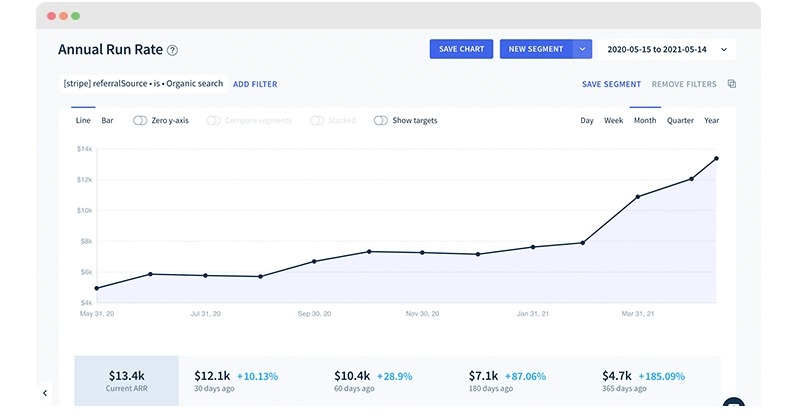
By segmenting the ARR or MRR charts inside ChartMogul by channel, you can see how much new revenue has been generated by channel each month.
And if you need to, you can get more granular and look at how much new revenue was generated by campaign, ad group, etc.
This information can be very helpful in determining ROI metrics, such as Time to Payback and ROAS. By comparing the amount you spent per channel or campaign with the amount of revenue you generated from them, you can ascertain whether these activities are returning a positive ROI or not and adjust accordingly.
ARPA by Channel
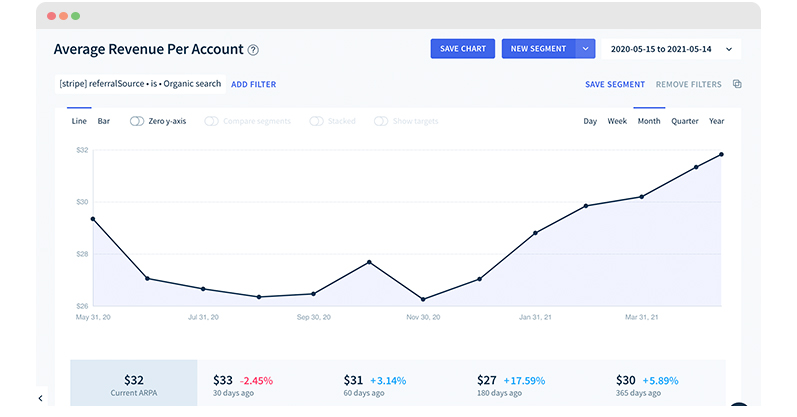
By segmenting the ARPA and ASP charts inside ChartMogul by channel, you can get an understanding of which channels are bringing in more higher paying customers.
And again, if you need to you can get more granular and look at the ARPA or ASP by campaign, ad group, etc.
This information is predominantly useful for comparing channels & campaigns against each other. For instance, imagine you provide HR software and you are running Facebook Ad campaigns into different industries, including retail, hospitality & beauty (nail salons, hair salons, etc). You could use this report to understand which of the campaigns are driving you higher paying customers and optimise accordingly.
LTV by Channel
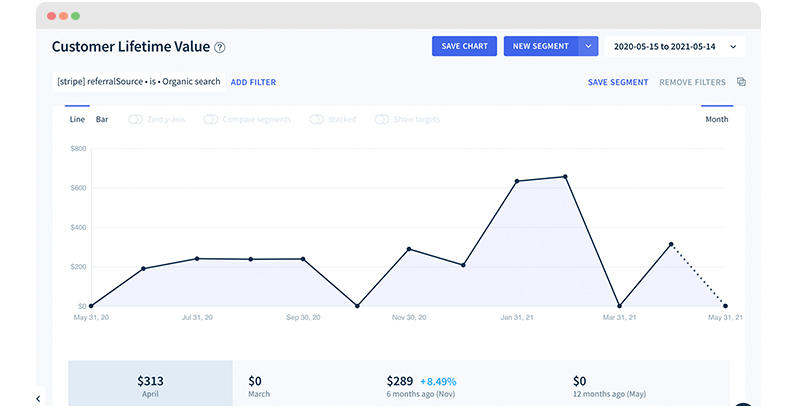
Like the ARPA & ASP charts above, by segmenting the LTV chart by channel or campaign you can get an understanding of which activities are driving more valuable customers.
The difference with the LTV chart however, is that it takes into account Churn to show overall value as opposed to the shorter term view that ARPA & ASP provide.
Start analysing your marketing today
If you’re using revenue tools like ChartMogul to track your new customers, MRR growth, Customer LTV, etc then you absolutely should be sending marketing channel data in so that you can segment these metrics by channel and understand what’s working and what isn’t.
Doing so has led to many useful insights for us at Simul. We’ve been able to learn that Organic Search accounts for about 80% of our customers & revenue, and that some of our Google Ads campaigns that were delivering a high amount of signups (due to the high search volume) weren’t actually converting into customers and subsequently should be discontinued.
